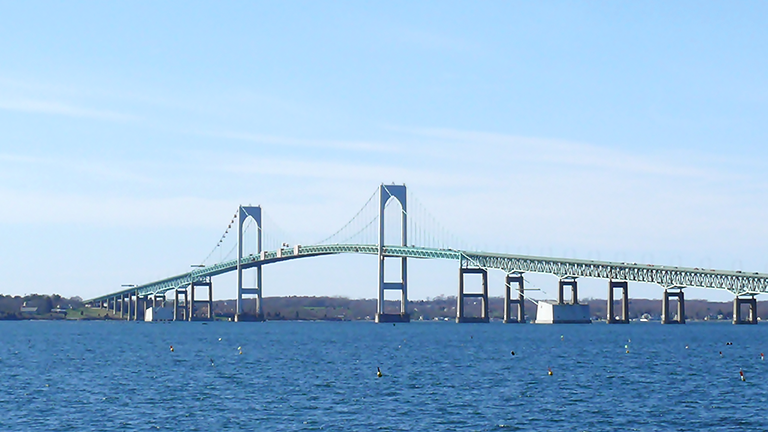
Obviously, water pollution harms Narragansett Bay, the sea life that inhabits it, and the people who depend on the Bay for their livelihood. For over 200 years, ever since the Industrial Revolution when chemicals and metals were dumped into the Blackstone River, the Bay has suffered from pollution. While mills of industry are no longer dumping waste into our rivers, major sources of pollution still exist. These days, that includes cesspools and septic systems, stormwater runoff, and wastewater treatment plants. Each of these add to high levels of phosphorus, nitrogen, and bacteria, as well as introducing chemicals, petroleum products, pharmaceuticals, and metals that flood into the Bay and other local waters.
These pollutants lead to beach closures and the closing of shellfish beds, as well as pose risks to public health and safety. After heavy rains, beds for clams, mussels, scallops, and oysters are often closed because bacteria in sewage from polluted runoff and wastewater system overflows make the shellfish unsafe to eat. One indicator of Bay health, and an important source of habitat and food for marine life, is eelgrass, which has decreased to just 10% of its once-thriving status in the Bay.
Save the Bay, an organization that started as a grassroots movement in 1970, is striving to reduce nitrogen and phosphorus in the Bay. While these nutrients are essential for marine life, excessive amounts can cloud the water and reduce oxygen levels, which literally chokes the life out of the Bay — killing aquatic species and habitats such as eelgrass. Save the Bay is fighting for the construction of and upgrades to wastewater treatment plants and septic systems, the elimination of cesspools, and investments in stormwater control projects. While nutrient pollution in urban waters has decreased through recent environmental protection efforts, there is still much work to be done until the Bay can be restored.
One way to curb the pollution of the Bay is to reduce polluted runoff and improve stormwater management. Reducing stormwater pollution is complicated. When it rains, water flows into the Bay from streets, highways, driveways, parking lots, lawns, and farms. This stormwater carries sewage from cesspools and sewer systems which overloads the Bay with nutrients. Stormwater can also cause major flooding when it is not properly managed.
Save the Bay seeks to educate municipal and state governments, homeowners, and business owners on how to reduce their stormwater runoff. Current efforts include educating malls and big box stores about how to landscape and reengineer their parking lots to capture their stormwater so that it sinks into the ground as it would naturally, rather than flowing into our waterways. Rain gardens are also being developed by schools, homeowners, and stores to accomplish the same goal. In addition, repairs and upgrades are being made to the stormwater collection systems run by cities and towns. The storm drains and pipes need consistent maintenance in order to run properly. Legislation has been introduced to increase inspections and control the quality of these systems.
Save the Bay has three Waterkeepers who engage in collecting and interpreting data to affect policy and inform the public. Mike Jarbeau acts as the Baykeeper and is responsible for identifying and responding to environmental threats by staying in close contact with members of the bay community and environmental agencies. The Baykeeper program was created in 1993 to strengthen Save the Bay’s capacity to respond to pollution and serve as a watchdog.
Dr. Catie Alves works as the Coastkeeper for Save the Bay. She works in the community on and off the water to restore, protect, and promote the idea of stewardship of the waterways of the Little Narragansett Bay, the Pawcatuck River, and the South Coast. The Coastkeeper initiative began in 2007 and established Save the Bay’s presence in Southern Rhode Island.
The third Waterkeeper post is the Riverkeeper, a position held by Kate McPherson. The Riverkeeper works to promote stewardship, and protect and restore the network of rivers within the Narragansett Bay watershed. Massachusetts is home to about 60% of these rivers. The Riverkeeper program began in 2016 in order to monitor Narragansett Bay’s tributary watershed, which includes, but is not limited to, the Taunton, Cole, Lee, Palmer, Kickemuit, Ten Mile, Runnins, and Blackstone Rivers.
One of the most important things everyone can do to aid in the restoration of Narragansett Bay and the environment as a whole, is to understand how to reduce harm and what can be done on an individual level to protect our waterways and beyond. Providing resources and educational programs to help inform both adults and children is one of Save the Bay’s primary initiatives. Many people are unaware of the simple things they can do that would have a huge impact on the environment around them, such as participating in beach cleanups, disposing of household hazardous waste properly, installing rain barrels to reduce rainwater runoff, and reducing or eliminating the use of chemical fertilizers, pesticides, and herbicides. A concentrated effort by Save the Bay, the Narragansett Bay Commission, and the public can help ensure our waters and natural resources can thrive for future generations.
More Posts by The Author:
A Breath of Fresh Air: The Soapbox Saints bring rockabilly into the modern day
Album Review: Rale Micic’s Only Love Will Stay
Growing MJ in RI
Wilma Briggs: A league of her own
The Quahogs: Homegrown rock & roll

